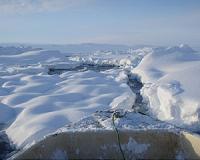 |
Kodiak, Alaska (AFP) April 4, 2011 Environmental groups and fishermen are sounding the alarm over planned US Navy live-fire exercises they claim threaten marine wildlife including whales in the Gulf of Alaska. They are also angry at plans to sink a decommissioned warship in the north Pacific area, one of the most productive commercial fishing grounds in US waters, at the heart of Alaska's economy. "I know the Navy has to practise," said Alaska Marine Conservation Council Board chairman Dave Kubiak, a commercial fisherman. "I just wonder why they have to do their practices in one of the richest fishing grounds in the world." At the heart of the row is the Navy's use of mid-frequency sonar which has documented links to the deaths of marine mammals in Mediterranean and Atlantic waters. The Navy plans to stage two 21-day joint anti-submarine exercises this summer in the Gulf of Alaska, as well as sink a decommissioned warship at least 50 nautical miles (90 kilometers) offshore. The exercises would involve live-fire gunnery and using medium-frequency sonar to hunt submarines in the narrow underwater channels in a 42,146 square-nautical-mile (145,482-square-kilometre) area east of Kodiak Island. Federal regulators downplay the threat even as environmentalists sound the alarm. "There is certainly no denying that the activities that the Navy does have impacts on marine mammals," said Jolie Harrison, a National Marine Fisheries Service biologist supervising the permit her agency is issuing the Navy. "But we've been working with them for several years to figure out how best to minimize those." The five-year permit being finalized allows the disturbance of about 425,000 marine mammals per year. It also allows the incidental death of up to 15 beaked whales over five years. The Navy admits to five documented cases where military sonar was linked to the strandings of marine mammals and the deaths of beaked whales specifically. The US Navy's use of medium-frequency sonar was involved in one of those cases, a 2000 incident that saw seven animals die in the Bahamas. Environmentalists have challenged the Navy's sonar plans, and a case reached the US Supreme Court in 2008 with a 5-4 court decision siding with the Navy, although it did not completely exempt the military from complying with environmental laws. In response, the Navy agreed to undertake an environmental study which it completed this month that lays out its plans in detail. A formal decision is expected after the comment period closes April 11. "We use lookouts and acoustic devices that are on the ship to make sure we have cleared that area of marine mammals," said US Navy Pacific Command environmental planner Alex Stone. The Natural Resources Defense Council, one of the Navy's past legal adversaries, says it is skeptical. "The Navy can't impose any of these mitigation measures because it doesn't know the distribution or 'hot spots' (of marine habitat) in the area," said NRDC staff attorney Taryn Kiekow. Impacts to fish are also under scrutiny. The Navy's report acknowledges that it operates in some of the most productive commercial fishing grounds in the United States. The Gulf of Alaska is feeding grounds for Pacific halibut, salmon, cod and others at the heart of Alaska's fishing economy. The National Marine Fisheries Service asked the Navy not to use munitions in areas it has identified as sensitive fish habitat, draw up a fish mortality plan and closely partner with its biologists. The Navy has agreed not to sink ships in sensitive areas but refused to commit further, and insists fears are unwarranted. "We're not going to have a long-term impact on the fishing community up there," said Stone. Alaska Native tribes, which are heavily invested in commercial and subsistence fishing in the gulf, have also weighed in. Rick Rowland, natural resources director for the Kodiak-based Sun'aq Tribe, says the tribe is sympathetic to national security needs but has concerns. "We don't advocate for anything that is negatively affecting the salmon or the sea mammals that are out there." Marine biologists say meanwhile they will be on alert this summer for signs of unusual activity. "If we can know the window of time when the exercises are going on then we'll just be more alert, have a heightened awareness," said University of Alaska Fairbanks associate professor Kate Wynne, a marine mammal specialist. "We'll put out flyers for the coastal pilots and everyone on the beaches to just look out for carcasses."
Share This Article With Planet Earth
Related Links Beyond the Ice Age
 Study Sheds Light On How Heat Is Transported To Greenland Glaciers
Study Sheds Light On How Heat Is Transported To Greenland GlaciersWoods Hole MA (SPX) Mar 30, 2011 Warmer air is only part of the story when it comes to Greenland's rapidly melting ice sheet. New research by scientists at Woods Hole Oceanographic Institution (WHOI) highlights the role ocean circulation plays in transporting heat to glaciers. Greenland's ice sheet has lost mass at an accelerated rate over the last decade, dumping more ice and fresh water into the ocean. Between 2001 and ... read more |
|
| The content herein, unless otherwise known to be public domain, are Copyright 1995-2010 - SpaceDaily. AFP and UPI Wire Stories are copyright Agence France-Presse and United Press International. ESA Portal Reports are copyright European Space Agency. All NASA sourced material is public domain. Additional copyrights may apply in whole or part to other bona fide parties. Advertising does not imply endorsement,agreement or approval of any opinions, statements or information provided by SpaceDaily on any Web page published or hosted by SpaceDaily. Privacy Statement |